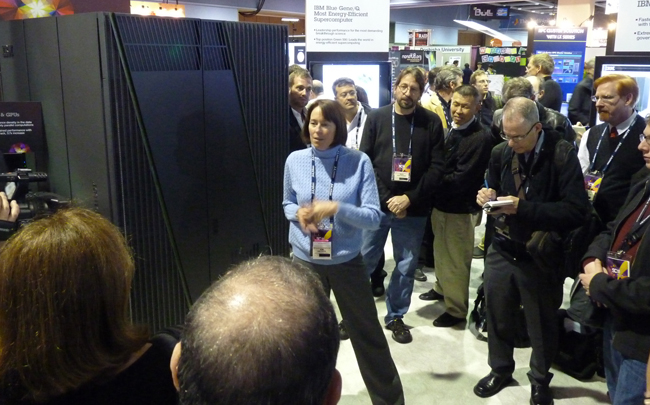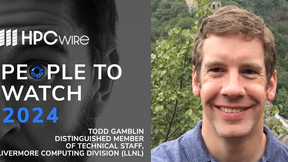IBM unveils BlueGene/Q at SC11
 (Download Image)
Kim Cupps, leader of the high performance computing division, talks to reporters following the unveiling of Blue Gene/Q (the cabinet to her left) at SC11 in Seattle. Photo credit: Wayne Butman/LLNL
(Download Image)
Kim Cupps, leader of the high performance computing division, talks to reporters following the unveiling of Blue Gene/Q (the cabinet to her left) at SC11 in Seattle. Photo credit: Wayne Butman/LLNL
"We're looking forward to running codes on the 20-petaflop Sequoia system in 2012," Cupps said. "We expect to achieve many exciting results in areas of national importance including: uncertainty quantification, materials modeling, energy modeling, laser plasma interaction and climate change. "This machine is an amazing achievement. We began our partnership with IBM more than 15 years ago with a goal of achieving 100 peak TeraFLOPs in 10 years," she said. "We achieved our goal twice in 2005: with the 360-teraflop BlueGene/L machine and the 100-teraflop Purple machine."
Cupps noted that just six years later "we are standing in front of a machine on a per rack basis that is 36 times more powerful than BlueGene/L and 10 times more energy efficient."
Jim Herring, IBM director of HPC Offerings, kicked off the event in IBM's SC11 booth before a group of reporters. Rick Stevens, deputy associate director at Argonne National Laboratory, also spoke. For the second time this year, BlueGene/Q was ranked No. 1 on the Green 500 list of the world's most energy efficient computers. Energy efficiency remains one of the greatest challenges for next-generation exascale supercomputers.
"Energy efficiency was a critical factor in selecting this machine and will continue to be of paramount importance as we move toward more powerful machines in the future," Cupps said. The BlueGene/Q Sequoia system is scheduled for delivery to LLNL for NNSA's Advanced Simulation and Computing program starting in December with deployment in 2012. When completed, Sequoia is expected to be one of the most powerful supercomputers in the world.
The ranking of the top 10 supercomputers on the industry-standard Top500 list of the world's fastest supercomputers remained unchanged, though several systems showed performance improvements. The new list was released at SC11 Tuesday. Japan's "K" computer is the world's fastest supercomputer, clocking 10 petaFLOP/S (quadrillion floating operations per second). See the Top500 Website for a complete list.
Contact
Donald B Johnston[email protected]
925-423-4902
Tags
HPC, Simulation, and Data ScienceSupercomputing
Computing
HPC Innovation Center
Featured Articles







